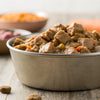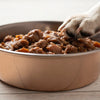Is It Good to Give Dogs Wet Food? An In-Depth Exploration
- Houndsy
Table of Contents
- Introduction
- Understanding the Basics: Wet vs. Dry Dog Food
- The Benefits of Wet Dog Food
- Drawbacks of Wet Dog Food
- Mixing Wet and Dry Food
- Is Wet Food Right for Your Dog?
- Conclusion
Introduction
Did you know that approximately 75% of dogs are not adequately hydrated? As devoted pet owners, we constantly seek the best ways to keep our furry companions healthy and happy. One often-overlooked aspect of dog care is diet, particularly the choice between wet and dry food. With a plethora of options available on the market, the question remains: Is it good to give dogs wet food?
In this article, we’ll dive deep into the nuances of wet and dry dog food, exploring the benefits and drawbacks of each. We’ll also examine how these foods affect our dogs’ overall health and well-being. By the end of our discussion, you will have a clearer understanding of whether wet food is a suitable choice for your canine companion and how it may fit into their daily diet.
We’ll cover various factors such as the nutritional content, convenience, palatability, and overall health implications of wet dog food. We invite you to ponder your dog’s eating habits and health as we explore these vital topics. Ultimately, we aim to empower you to make informed decisions about your dog’s diet.
Understanding the Basics: Wet vs. Dry Dog Food
What Is Wet Dog Food?
Wet dog food typically comes in cans or pouches and is rich in moisture content, often around 75-80% water. This high moisture level can be beneficial for dogs who struggle with hydration or have specific medical conditions. Typically, wet dog food contains animal protein, fats, vitamins, and minerals, providing a balanced meal for your pet.
What Is Dry Dog Food?
Dry dog food, often referred to as kibble, has a significantly lower moisture content, typically about 10%. This dehydrated form of food is made through a process that involves cooking and then extruding the mixture into small, bite-sized pieces. While dry food tends to be more affordable and convenient, it may lack some hydration benefits that wet food provides.
Key Differences Between Wet and Dry Dog Food
- Moisture Content: Wet food is often preferable for dogs that don’t drink enough water.
- Palatability: Many dogs find wet food more appealing due to its aroma and flavor.
- Price and Shelf Life: Dry food is usually less expensive and has a longer shelf life compared to its wet counterpart.
- Dental Health: Dry food has the added benefit of helping reduce tartar build-up due to its crunchy texture.
These key differences can significantly impact the quality of life for your pooch. With this foundation, let’s explore the specific benefits and drawbacks of wet dog food.
The Benefits of Wet Dog Food
Increased Hydration
One of the most significant advantages of wet dog food is its high moisture content. According to veterinary research, incorporating wet food into a dog's diet can help enhance hydration, particularly for those that may not drink enough water during the day. This is especially critical for dogs with urinary issues or those that tend to be reluctant to drink.
- Healthy Urinary Tract: Ensuring sufficient hydration can reduce the risk of urinary tract infections and even kidney disease.
Enhanced Palatability
Most dogs find wet food incredibly appealing. The intense flavors and aromas can make meals more enjoyable, particularly for picky eaters or older dogs with diminished taste sensitivity. A dog that is more excited about their meals is less likely to graze or turn their nose up, leading to more consistent nutritional intake.
Easier to Chew
As dogs age, their dental health and chewing ability can decline. Wet food can provide a softer alternative that won’t cause discomfort. For senior dogs or those with dental issues, wet food can offer a much more palatable and nutritious option.
Satiety and Weight Management
Wet dog food often helps dogs feel fuller faster, which can aid in weight management. Thanks to its higher water content and denser nutrients, dogs fed wet meals may consume less food overall, staying satisfied without excessive calorie intake.
Nutritional Benefits
Some wet dog foods are richer in protein and lower in carbohydrates compared to their dry counterparts. For specific dietary requirements, opting for wet food can be a practical choice, especially for pets that require a protein-rich diet.
Drawbacks of Wet Dog Food
Higher Cost
Wet dog food is typically more expensive than dry food. For households with multiple pets or on a tight budget, this can become a notable disadvantage.
Shorter Shelf Life
Once opened, wet dog food should be refrigerated and consumed within a few days to prevent spoilage. This can be inconvenient for pet owners who cannot quickly finish an opened can or pouch.
Dental Health Concerns
While wet food can be easier for dogs to consume, some studies suggest that it does not effectively contribute to dental health. Chewing dry kibble can help reduce tartar buildup, meaning dogs exclusively on wet food may require additional dental care, such as brushing or dental chews.
Waste and Cleanliness
Feeding wet food can create messier mealtimes, necessitating a diligent cleanup routine. Additionally, wet food packaging generates more waste compared to dry food. Environmental-conscious pet owners may consider this factor when deciding on food types.
Mixing Wet and Dry Food
For many dog owners, the solution lies in finding a healthy balance. Mixing wet and dry dog food can deliver the best of both worlds. Here are some tips for effective mixing:
- Determine Caloric Needs: Consult your veterinarian to establish daily caloric requirements for your dog, taking into account activity level, age, and health conditions.
- Mix Gradually: Transition your dog into a mixed diet smoothly. Start by introducing small amounts of wet food, gradually increasing the quantity over several days.
- Store Properly: Be mindful of how you store any opened wet food to prevent spoilage, helping maintain freshness and flavor.
Enhancing Your Pet's Diet
Incorporating the Houndsy Kibble Dispenser into your feeding routine can further enhance the experience. With features such as perfect portion control and a design that pairs beautifully with modern home aesthetics, the Houndsy Kibble Dispenser is perfect for keeping dry kibble fresh and accessible while allowing mixing with wet food. Explore the Houndsy Kibble Dispenser here: Houndsy Kibble Dispenser.
Is Wet Food Right for Your Dog?
Factors to Consider
When contemplating whether wet food is suitable for your dog, consider the following factors:
- Health Concerns: If your dog suffers from health issues like kidney disease, consult your veterinarian about incorporating wet food.
- Age: Puppies and senior dogs often benefit greatly from softer diets that wet food provides.
- Personal Preferences: Ultimately, observe your dog’s preferences. Some dogs thrive on dry food, while others may show a clear preference for wet food.
Field Testing With Your Dog
Ideally, experiment with your dog’s dietary options. Introduce wet food while monitoring their responses. Is your dog eating more eagerly? Are their bathroom habits consistent? Engaging in this observational practice enables us to tailor our approach to best suit each dog.
Conclusion
In summary, the question of is it good to give dogs wet food boils down to understanding your dog’s unique needs and preferences. Wet dog food offers numerous benefits, including better hydration, increased palatability, and ease of chewing, making it an excellent choice for many dogs.
However, it’s essential to weigh these advantages against potential drawbacks, such as higher costs, the mess factor, and dental health concerns. Mixing both wet and dry food can also provide a balanced approach that caters to your dog’s well-being.
As always, consulting with your veterinarian will ensure that your feeding choices best support your dog’s health, vitality, and enjoyment. We hope you explore our wonderful feeding solutions at Houndsy, including the stylish and functional Houndsy Kibble Dispenser: Order Now.
FAQ
1. Can wet dog food help with hydration?
Yes, wet dog food has a high moisture content, which can aid in hydrating your dog, especially beneficial for dogs that may not drink enough water.
2. Is wet dog food more expensive than dry food?
Generally, yes, wet dog food can be more costly than dry options, but it can provide additional health benefits for specific needs.
3. How do I transition my dog to wet food?
Start with a gradual introduction by mixing a small amount of wet food with their current dry diet, slowly increasing the wet food portion over time.
4. Should I only feed my dog wet food?
It depends on your dog. Some thrive on wet food alone, while others prefer dry. It's crucial to ensure that whatever diet you choose is nutritionally balanced.
5. Does wet food affect dental health?
Wet food alone doesn’t help with tartar removal as effectively as dry food does. Regular dental care is essential for dogs on a wet food diet.
6. Can puppies eat wet food?
Yes, puppies can eat wet food as it is easier for their small, delicate teeth to chew. It can also enhance their eating experience during early development.
By offering a well-informed diet and incorporating the right feeding methods, we can ensure our furry friends are healthy, happy, and well-cared for.












